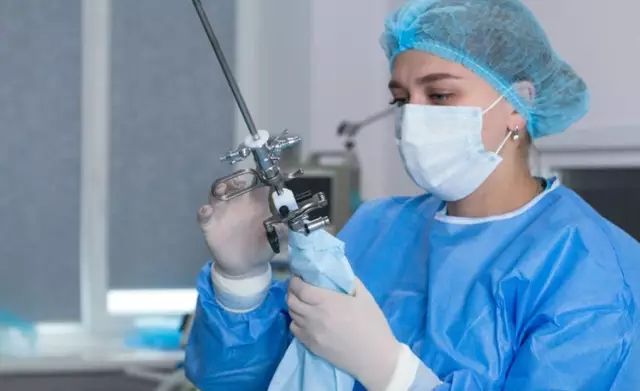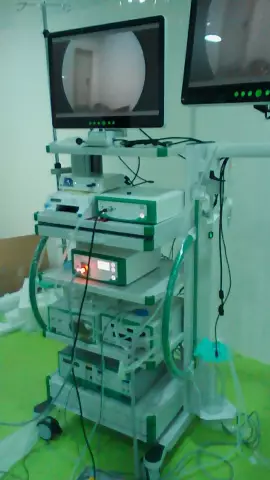- Author Curtis Blomfield [email protected].
- Public 2023-12-16 20:44.
- Last modified 2025-01-23 17:01.
Hysteroscopy with separate diagnostic curettage (abbreviated as WFD) is a method for diagnosing gynecological diseases and removing various neoplasms. Many women experience this procedure, and almost everyone is afraid of it, since the term "curettage", used in simple speech, sounds somewhat unpleasant. Today we will consider this method in more detail, find out how it is carried out, in what cases it is shown and what are its consequences.
A bit of anatomy…
The uterus is an organ covered with a mucous membrane, which is different from the mucous membranes of other organs. After all, its main task is to preserve the pregnancy. Every month the thickness of the uterus gradually increases. If conception does not occur (after all, we often have different plans with nature), this thickened layer comes out in the form of menstrual blood. The process then repeats.

What is a hysteroscopy?
You can call this procedure the "golden medical mean." It makes it possible to visualize the uterine cavity, revealing various neoplasms - polyps, adhesions, adhesions, submucosal nodes (uterine fibroids) and other neoplasms, includingmalignant nature. But the purpose of the study is not only diagnostic. During the procedure, adhesions can be dissected, cryodestruction of polyps (exposure to low temperature), an intrauterine device can be removed or detected.
Hysteroscopy with RFE resembles an abortion - all formations in the uterus are removed along with its upper layer. However, if earlier the procedure was very painful, today curettage is performed using analgesics that help eliminate pain. Previously, hysteroscopy was also actively carried out, but due to the impossibility of visualizing the manipulation, frequent complications were observed, up to the removal of the basal layer of the uterus and the inability to become pregnant. Today, thanks to hysteroscopy, the doctor sees everything that happens inside. The risk of any damage in this case is minimal. Although in many ways it all depends on the qualifications of the doctor.

Attention! In 90% of cases, the method allows you to confirm a previously diagnosed diagnosis.
First, curettage is carried out under the control of hysteroscopy of the mucous layer of the cervix, and then the uterus itself.
Hysteroscopy: indications for use
Hysteroscopy indicated:
- For menstrual irregularities, the causes of which could not be diagnosed by other studies.
- Myoma (a benign tumor on the muscle layer of the uterus).
- Tumor processes.
- Endometrial dysplasia (excessive growth of the inner uterine layer).
- Remediationincomplete abortion, which caused inflammation.
- Infertility.
- Spontaneous miscarriage.
Diagnosis of many diseases with hysteroscopy with WFD greatly facilitates the treatment process, since the doctor can remove neoplasms immediately upon detection. Or send the histological material taken from the uterine cavity to the laboratory. That is why the procedure is performed under general anesthesia.

Is there a risk of complications?
Hysteroscopy with RFE was indeed fraught with serious complications. Today, the procedure is almost completely safe, and complications are observed in only 1% of cases. Among them, the following are common:
- Injury to the uterus or cervix. It is accompanied by a sharp pain in the abdomen, a decrease in blood pressure up to fainting.
- Infection or exacerbation of those diseases that were not diagnosed before the study. Often, inflammation occurs with an untreated illness or poor hygiene.
- Endometritis (inflammation of the upper inner layer of the uterus) reports itself with aching pains in the abdomen, fever and bloody discharge from the vagina. Appears within a few days after surgery.
- Oxygen entering the uterine blood vessels.
- Profuse bleeding. Bloody discharge after surgery is observed within 3-5 days, but if it is very abundant and lasts for several days, then you should immediately consult a doctor.
- Side effectsas a reaction to anesthesia.
- Hematometer. The accumulation of blood in the uterine cavity may appear when a hysteroscopy with RFE was performed to eliminate uterine spasm. If the uterus remains in a state of spasm, the blood in it, which should be released for several days, accumulates, causing pain.

There is also a risk of damage to the lining of the uterus. The doctor may accidentally hook on a deeper layer of the mucosa of the organ. It can no longer be restored, so it is very important that such gynecological operations be performed by an experienced doctor who is guaranteed not to catch anything superfluous.
How is the procedure?
Many women are primarily interested in this issue, as the upcoming surgery scares them. But in fact, you have nothing to fear - the operation takes place under general anesthesia and usually does not cause any discomfort to the woman. The description is based on feedback from women who have had gynecological surgery before. Before the procedure, it is important to take swabs to check the degree of purity of the vagina, to exclude the possibility of syphilis and HIV infection.

You need to arrive at the gynecological center 30-40 minutes before the operation. In the morning, it is important not to eat any food. Blood and urine are taken for analysis, an ECG is performed (shows the work of the heart and blood vessels), and blood pressure is measured. A consultation with a surgeon and an anesthesiologist is carried out. Legs are bandaged up to the knee to avoid blood clots.
In the verythe operating room is given an injection into a vein - a light anesthesia, which allows the procedure to be completely painless for the patient. After 20 minutes, the curettage itself, as well as the effect of anesthesia, ends. The patient is put on a drip. If hysteroscopy with WFD was performed in the morning, then in the evening you can go home with peace of mind. The very next day after her, women go to work. Hysteroscopy (price will be indicated below) does not require a long recovery.
After the operation, as doctors warn, there is a possibility of drawing pain and spotting in a small amount. It is forbidden to have sex and exercise for about 2 weeks. Medicines are also prescribed. First of all, an antibiotic ("Amoxiclav", etc.) and a drug based on lactic acid bacteria. If there is an increased level of spotting, appoint "No-shpu".

Are there any contraindications for hysteroscopy?
Hysteroscopy (or curettage) is categorically contraindicated:
- With severe uterine bleeding.
- Pregnancy.
- Cervical cancer.
- Inflammatory processes of the genital organs (vaginitis, endometritis, cervicitis, bacterial vaginosis).
Hysteroscopy before IVF
IVF is artificial insemination that takes place outside the woman's body. A fertilized egg from a test tube is transplanted into the body of a future mother. One of the most common methods of solving the issue of infertility. Hysteroscopy with WFDbefore IVF makes it possible to exclude uterine pathologies and prepare the body for a future pregnancy. IVF is recommended within a few months after the procedure.

Prices for hysteroscopy
Hysteroscopy, the price of which varies widely from clinic to clinic, is performed in every city. In Moscow clinics, the cost of the procedure can cost from 5,000 to 40,000 rubles. The price depends on the level of the clinic, the quality of the equipment, the procedure itself and other factors. Before choosing an institution, be sure to read the reviews about it.
Hysteroscopy is performed in the following Moscow clinics:
- "Delta Clinic" (5000 rubles).
- Medicina OJSC (43,000 rubles).
- GMS Clinik (25,000 rubles).
- MC "Petrovsky Gates" (18,000 rubles).
- "ABC-medicine" (10,000 rubles).
Choose any gynecological center in Russia that suits you according to reviews and prices. Stay he althy!






